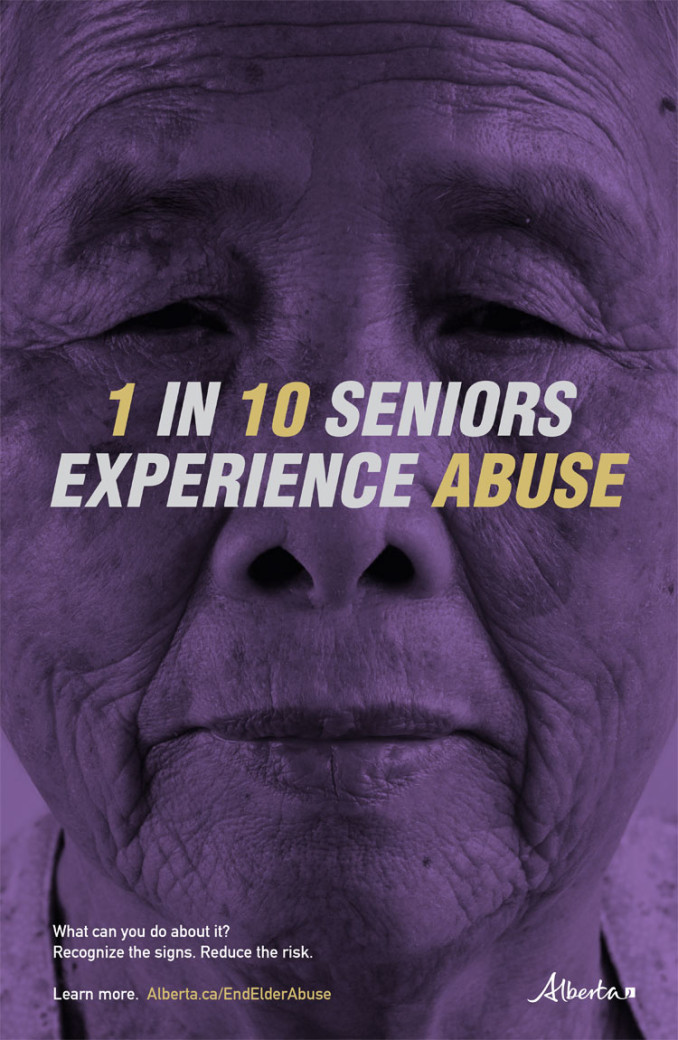Government mail service may be affected by the Canada Post labour disruption. Learn about how critical government mail will be handled.
Overview
Elder abuse is a serious issue – it's estimated that nearly one in 10 Alberta seniors may be victims of some form of elder abuse.
Any senior can become a victim of elder abuse regardless of gender, sexual identity, race, ethnicity, income or education.
Get help
- Call 911 if you or someone you know is in immediate danger.
- Family Violence Info Line: call or text 310-1818 (24-hour, toll free in more than 170 languages), or chat online (to start a chat, click on the message icon in the bottom right of the screen – available in English only).
- Additional helplines and supports.
- Resources and publications.
Elder abuse prevention strategy
A collective approach: Alberta’s strategy for preventing and addressing elder abuse is a new 5-year strategy to guide how Albertans, non-profit organizations, frontline workers, businesses and governments can work together to prevent and reduce elder abuse.
The new strategy:
- updates Alberta's definition of elder abuse
- includes goals and actions to make Alberta safer for seniors
- outlines new approaches for:
- recognizing and responding to financial abuse
- increasing awareness of elder abuse
- improving service provider training
- enhancing data collection and program development
- supporting community responses
- strengthening protective laws and policies
Learn more about Alberta’s elder abuse prevention strategy.
What elder abuse is
Elder abuse includes any intentional or reckless act or wilful and negligent disregard, occurring within a relationship of family, trust or dependency, directed at someone 65 years of age or older, that:
- causes physical, emotional or psychological harm
- involves the misappropriation or misuse of money or other personal possessions or personal or real property
- subjects an individual to non-consensual sexual contact, activity or behaviour
- fails to provide the necessities of life
Elder abuse awareness videos
Darlene’s story
Lauree’s story
Georgina’s story
Signs of elder abuse
- confusion
- depression or anxiety
- unexplained injuries
- changes in hygiene
- seeming fearful around certain people
- fear or worry when talking about money
Helplines and supports
Call 911 if you or someone you know is being abused and is in immediate danger.
Resources
Elder abuse fact sheet
-

- English
- Français (French)
- العربية (Arabic)
- Siksiká (Blackfoot)
- 简体中文 (Chinese – Simplified)
- 繁體中文 (Chinese – Traditional)
- nêhiyawêwin (Plains Cree)
- Deutsch (German)
- Italiano (Italian)
- ਪੰਜਾਬੀ (Punjabi)
- Soomaali (Somali)
- Español (Spanish)
- Kiswahili (Swahili)
- Tagalog (Tagalog)
- ትግርኛ (Tigrinya)
- Українська (Ukrainian)
- Tiếng Việt (Vietnamese)
Stop elder abuse poster
Other resources
- A collective approach: Alberta’s strategy for preventing and addressing elder abuse 2022-2027
- A Guide to Decision-Making: Protecting Individual Rights and Reducing the Risk of Elder Abuse
- Addressing Elder Abuse: A Toolkit for Developing a Coordinated Community Response
- Financial Abuse of Seniors: What can financial abuse of a senior look like?
- It's your money: Protect yourself from financial abuse
This resource is available in multiple languages. Check the ‘Related’ tab on the Open Government page to find your language. - Perceptions of aging and older adults
- Preventing and responding to the mistreatment of older adults: Gaps and challenges exposed during the pandemic
- Service Provider Screening Guide for Elder Abuse
This resource is available in multiple languages. Check the ‘Related’ tab on the Open Government page to find your language. - Social Isolation: The relationship between social isolation and elder abuse
This resource is available in multiple languages. Check the ‘Related’ tab on the Open Government page to find your language. - Spot the difference: Learn to recognize elder abuse, bullying, frauds and scams
This resource is available in multiple languages. Check the ‘Related’ tab on the Open Government page to find your language. - Understanding Privacy Legislation: A Guide to Help Service Providers Identify and Respond to Elder Abuse
Contact
Call 911 if you or someone you know is being abused and is in immediate danger.
For support, information or referrals, call or text the Family Violence Info Line at 310-1818 (24-hour, toll-free in more than 170 languages) or chat online (to start a chat, click on the message icon in the bottom right of the screen – available in English only).
For other inquires or questions about program policy, connect with the Seniors Strategic Planning Branch, email: [email protected]
Related
- Coordinated community response to elder abuse
- Family violence prevention – Publications
- Victim serving organizations
- Consumer protection
- Alberta Elder Abuse Awareness Council
- The Canadian Network for the Prevention of Elder Abuse
- Seniors Canada
- Federal/Provincial/Territorial Ministers Responsible for Seniors Forum
